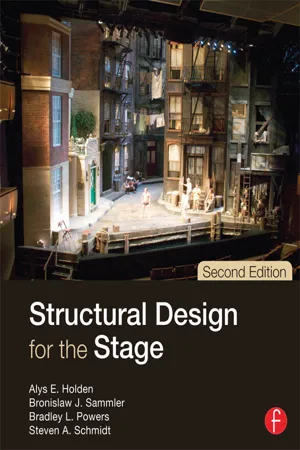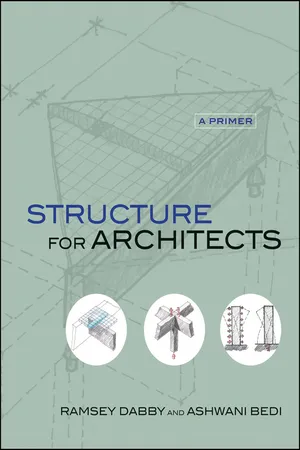Physics
Tension
Tension in physics refers to the force transmitted through a string, rope, cable, or similar object when it is pulled tight by forces acting from opposite ends. It is a pulling force that arises when an object is being stretched. Tension is an important concept in understanding the behavior of structures and the dynamics of objects in motion.
Written by Perlego with AI-assistance
Related key terms
Related key terms
1 of 4
Related key terms
1 of 3
3 Key excerpts on "Tension"
- eBook - ePub
- Alys Holden, Bronislaw Sammler, Bradley Powers, Steven Schmidt(Authors)
- 2015(Publication Date)
- Routledge(Publisher)
2 Force, Stress, and StrainDOI: 10.4324/9781315697857-2Introduction
The first step in understanding any science is to learn its language. Like other specializations, technical theater has a unique vocabulary incomprehensible to most laypeople. Blank stares and puzzled looks are common reactions when a technician discusses very simple items such as “flats,” “keystones,” “crosbys,” etc. These terms are not hard to understand once they’ve been defined. Structural design, like technical theater, has its own specialized vocabulary, one which is not especially difficult to understand, and which makes the discussion of structural design concepts easier. This vocabulary lets structural designers get to the root of a problem without getting lost in the details.This chapter defines many of the basic terms pertaining to structural design. Though at first glance these definitions may seem unrelated, the remaining chapters will provide a framework which demonstrates how they are linked.Force
A force is a push or pull. Newton’s Second Law states that a force acting on an object tends to move the object in the direction of the force. This tendency is called translation. To be completely defined a force’s magnitude, line of action, direction, and sense must be specified.- The magnitude of a force, is measured in pounds or kips (one kip is 1,000 pounds) in the U.S. and is an absolute value.
- The line of action of a force is its straight-line path both before and after it.
- The direction of a force is the relationship between its line of action and a reference line, such as a horizontal or vertical line.
- The sense of a force is positive or negative with each direction having two possible senses. A horizontal force can only push or pull to the right or left; and a vertical force can only push or pull up or down. By convention in this text, forces acting up or to the right are considered positive, and forces acting down or to the left are considered negative.
- eBook - ePub
- Hani M. Tawancy, Anwar Ul-Hamid, Nureddin M. Abbas(Authors)
- 2004(Publication Date)
- CRC Press(Publisher)
In the preceding discussion, a body acted upon by a system of forces is assumed to be rigid or nondeformable. When a product is designed for mechanical or structural functions, the designer is primarily concerned with mechanical properties of the materials to be used in manufacturing. Specifically, the designer wishes to know the effects of an applied force on the material. To accommodate the effect of an applied force, whether it is small or large, the material is deformed or is said to be strained. Simultaneously, the material develops internal forces or stresses to counteract the effect of an applied force. Therefore, the effect of an applied force can be analyzed in terms of the concepts of strain and stress defined below.3.9 Concept of Strain
When a body is acted upon by an external force, it undergoes some type of distortion or deformation, which can be a change in shape, volume, or both. All types of materials are characterized by a relative tendency to recover from such distortion upon the removal of the applied force; i.e., the body restores its original shape or volume. In effect, materials tend to resist and recover from deformation. Such a tendency is called elasticity (see Fig. 1.4 ).Figure 3.4 schematically illustrates the three main types of deformation, namely, (i) simple one-dimensional stretch (Tension) or compression (Fig. 3.4a), (ii) a shearing or twisting type of deformation (Fig. 3.4b), and (iii) overall fractional change in volume or dilation, which can be either expansion or contraction (Fig. 3.4c).Deformation is expressed in terms of a derived concept called strain. It is defined as the fractional change in dimension or volume. In the case of one- dimensional stretch or compression shown in Fig. 3.4a, the axial strain e is defined aswhere L is the length of the body corresponding to an applied tensile force F, and L0 is the initial length. Since L > L0 , the tensile strain e is positive. Conversely, for compression, where L < L0 , the compressive strain e is negative. Axial strain such as that shown in Fig. 3.4a is accompanied by a transverse strain. As can be seen, when the body is stretched along its axis, it is simultaneously contracted along the perpendicular direction. In this case, the transverse strain etr - eBook - ePub
Structure for Architects
A Primer
- Ramsey Dabby, Ashwani Bedi(Authors)
- 2012(Publication Date)
- Wiley(Publisher)
CHAPTER 4 States of StressWhile loads are external forces applied to a body, stress is the internal resistance of the body to those forces. There are three basic types of stress: Tension, compression , and shear . All stress consists of these three basic types or some combination thereof.4.1 TensionTension is the tendency of a body to be pulled apart. The rope in Figure 4.1a has direct tensile stress acting on it (the two men pulling on each end) in a direction perpendicular to its cross section (Figure 4.1b ).Figure 4.1a A Rope in Tension4.2 CompressionFigure 4.1b Direct Tensile StressCompression is the tendency of a body to be crushed. The post in Figure 4.2a has direct compressive stress acting on it (the downward force and the upward resistance of the ground) in a direction perpendicular to its cross section (Figure 4.2b ).Figure 4.2a A Post in Compression4.3 ShearFigure 4.2b Direct Compressive StressShear is the tendency of a body to be sliced. The bolt in Figure 4.3a has direct shear stress acting on it (the two bars pulling in opposition to each other) in a direction parallel to its cross section (Figure 4.3b ).Figure 4.3a A Bolt under Shear4.4 TorsionFigure 4.3b Direct Shear StressTorsion is a type of shear in which a body tends to be twisted, resulting in shear stresses (Figures 4.4 and 4.5 ).Figure 4.4 A Pole Sign under Torsion4.5 BendingFigure 4.5 A Spandrel Girder under TorsionBending is the tendency of a body, such as a beam, to bow, thereby creating stress in the body. When bowed, the body compresses along one edge and stretches along the other. The bending of a simply supported beam under load produces Tension along the bottom of the beam and compression along the top (Figure 4.6 ). Moving away from the Tension and compression edges toward the centerline of the beam, the tensile and compressive stresses gradually diminish until they reach zero. The imaginary plane passing through the centerline of a beam along its length, at which no Tension or compression occurs, is called the neutral plane or neutral axis . Although bending is of paramount importance in beams, it may occur in any structural member, including columns. Bending is also referred to as flexure.
Index pages curate the most relevant extracts from our library of academic textbooks. They’ve been created using an in-house natural language model (NLM), each adding context and meaning to key research topics.
Explore more topic indexes
Explore more topic indexes
1 of 6
Explore more topic indexes
1 of 4


